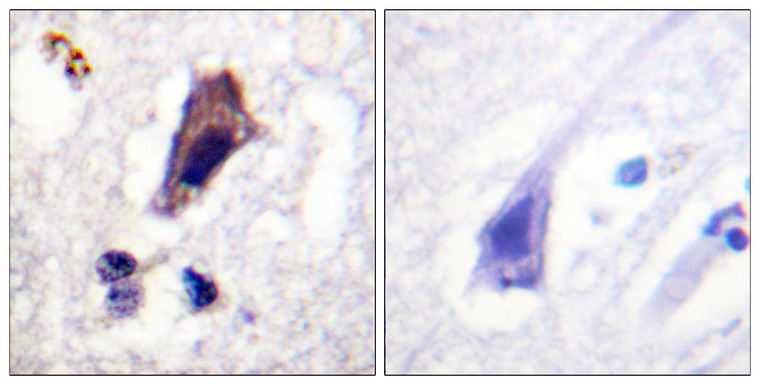| Host: |
Rabbit |
| Applications: |
IHC/IF/ELISA |
| Reactivity: |
Human/Mouse/Rat |
| Note: |
STRICTLY FOR FURTHER SCIENTIFIC RESEARCH USE ONLY (RUO). MUST NOT TO BE USED IN DIAGNOSTIC OR THERAPEUTIC APPLICATIONS. |
| Short Description: |
Rabbit polyclonal antibody anti-Phospho-1-phosphatidylinositol 3-phosphate 5-kinase-Ser307 (273-322 aa) is suitable for use in Immunohistochemistry, Immunofluorescence and ELISA research applications. |
| Clonality: |
Polyclonal |
| Conjugation: |
Unconjugated |
| Isotype: |
IgG |
| Formulation: |
Liquid in PBS containing 50% Glycerol, 0.5% BSA and 0.02% Sodium Azide. |
| Purification: |
The antibody was affinity-purified from rabbit antiserum by affinity-chromatography using epitope-specific immunogen. |
| Concentration: |
1 mg/mL |
| Dilution Range: |
IHC 1:100-1:300IF 1:200-1:1000ELISA 1:10000 |
| Storage Instruction: |
Store at-20°C for up to 1 year from the date of receipt, and avoid repeat freeze-thaw cycles. |
| Gene Symbol: |
PIKFYVE |
| Gene ID: |
200576 |
| Uniprot ID: |
FYV1_HUMAN |
| Immunogen Region: |
273-322 aa |
| Specificity: |
Phospho-PIP5KIII (S307) Polyclonal Antibody detects endogenous levels of PIP5KIII protein only when phosphorylated at S307. |
| Immunogen: |
The antiserum was produced against synthesized peptide derived from the human PIP5K around the phosphorylation site of Ser307 at the amino acid range 273-322 |
| Function | Dual specificity kinase implicated in myriad essential cellular processes such as maintenance of endomembrane homeostasis, and endocytic-vacuolar pathway, lysosomal trafficking, nuclear transport, stress- or hormone-induced signaling and cell cycle progression. The PI(3,5)P2 regulatory complex regulates both the synthesis and turnover of phosphatidylinositol 3,5-bisphosphate (PtdIns(3,5)P2). Sole enzyme to catalyze the phosphorylation of phosphatidylinositol 3-phosphate on the fifth hydroxyl of the myo-inositol ring, to form (PtdIns(3,5)P2). Also catalyzes the phosphorylation of phosphatidylinositol on the fifth hydroxyl of the myo-inositol ring, to form phosphatidylinositol 5-phosphate (PtdIns(5)P). Has serine-protein kinase activity and is able to autophosphorylate and transphosphorylate. Autophosphorylation inhibits its own phosphatidylinositol 3-phosphate 5-kinase activity, stimulates FIG4 lipid phosphatase activity and down-regulates lipid product formation. Involved in key endosome operations such as fission and fusion in the course of endosomal cargo transport. Required for the maturation of early into late endosomes, phagosomes and lysosomes. Regulates vacuole maturation and nutrient recovery following engulfment of macromolecules, initiates the redistribution of accumulated lysosomal contents back into the endosome network. Critical regulator of the morphology, degradative activity, and protein turnover of the endolysosomal system in macrophages and platelets. In neutrophils, critical to perform chemotaxis, generate ROS, and undertake phagosome fusion with lysosomes. Plays a key role in the processing and presentation of antigens by major histocompatibility complex class II (MHC class II) mediated by CTSS. Regulates melanosome biogenesis by controlling the delivery of proteins from the endosomal compartment to the melanosome. Essential for systemic glucose homeostasis, mediates insulin-induced signals for endosome/actin remodeling in the course of GLUT4 translocation/glucose uptake activation. Supports microtubule-based endosome-to-trans-Golgi network cargo transport, through association with SPAG9 and RABEPK. Mediates EGFR trafficking to the nucleus. (Microbial infection) Required for cell entry of coronaviruses SARS-CoV and SARS-CoV-2, as well as human coronavirus EMC (HCoV-EMC) by endocytosis. |
| Protein Name | 1-Phosphatidylinositol 3-Phosphate 5-KinasePhosphatidylinositol 3-Phosphate 5-KinaseFyve Finger-Containing Phosphoinositide KinasePikfyvePhosphatidylinositol 3-Phosphate 5-Kinase Type IiiPipkin-IiiType Iii Pip KinaseSerine-Protein Kinase Pikfyve |
| Database Links | Reactome: R-HSA-1660514Reactome: R-HSA-1660516Reactome: R-HSA-1660517 |
| Cellular Localisation | Endosome MembranePeripheral Membrane ProteinEarly Endosome MembraneCytoplasmic VesiclePhagosome MembraneLate Endosome MembraneMainly Associated With Membranes Of The Late Endocytic Pathway |
| Alternative Antibody Names | Anti-1-Phosphatidylinositol 3-Phosphate 5-Kinase antibodyAnti-Phosphatidylinositol 3-Phosphate 5-Kinase antibodyAnti-Fyve Finger-Containing Phosphoinositide Kinase antibodyAnti-Pikfyve antibodyAnti-Phosphatidylinositol 3-Phosphate 5-Kinase Type Iii antibodyAnti-Pipkin-Iii antibodyAnti-Type Iii Pip Kinase antibodyAnti-Serine-Protein Kinase Pikfyve antibodyAnti-PIKFYVE antibodyAnti-KIAA0981 antibodyAnti-PIP5K3 antibody |
Information sourced from Uniprot.org
12 months for antibodies. 6 months for ELISA Kits. Please see website T&Cs for further guidance









